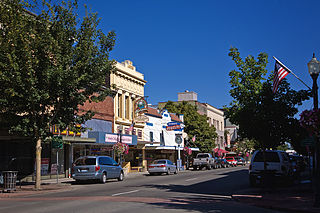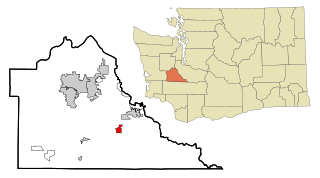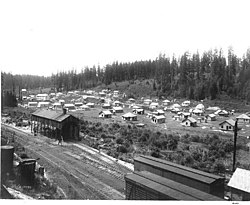
Thurston County is a county located in the U.S. state of Washington. As of the 2020 census, its population was 294,793. The county seat and largest city is Olympia, the state capital.

Centralia is a borough and near-ghost town in Columbia County, Pennsylvania, United States. It is part of Northeastern Pennsylvania. Its population declined from 1,000 in 1980 to five residents in 2020 because a coal mine fire has been burning beneath the borough since 1962. Centralia, part of the Bloomsburg–Berwick metropolitan area, is the least-populated municipality in Pennsylvania. It is completely surrounded by Conyngham Township.

Ravensdale is a census-designated place (CDP) in King County, Washington, United States. The population was 555 at the 2020 census.

Centralia is a city in Lewis County, Washington, United States. It is located along Interstate 5 near the midpoint between Seattle and Portland, Oregon. The city had a population of 18,183 at the 2020 census. Centralia is twinned with Chehalis, located to the south near the confluence of the Chehalis and Newaukum rivers.

Bucoda is a town in Thurston County, Washington, United States. The population was 600 at the 2020 census. The community refers to itself as the "World's Tiniest Town with the Biggest Halloween Spirit".

Rainier is a city in Thurston County, Washington, United States. Beginning as a train stop in the 1870s, Rainier was first settled in 1890 and would become known as a logging town. The city was officially incorporated in 1947.

Tenino is a city in Thurston County, Washington, United States. The population was 1,870 at the 2020 census.

The Skookumchuck River is a 45-mile (72 km) long river located in southwest Washington, United States. It is a tributary of the Chehalis River and thence to the Pacific Ocean. The Skookumchuck Dam was built in 1970, creating the Skookumchuck Reservoir. The dam provides water supply for the 1400-megawatt Centralia Steam Electric Plant and supplements flows for fish resources. The river begins with several tributaries in the Snoqualmie National Forest in the foothills of the Cascade Mountains, and flows west past the town of Bucoda, Washington to its confluence with the Chehalis River near Centralia, Washington.

Dawson is a ghost town in Colfax County, New Mexico, United States. Dawson is located approximately 17 miles northeast of Cimarron, and was the site of two separate coal mining disasters in 1913 and 1923. In 1950, the mines were closed, and by 1954 the last residents had left and the post office closed.

Mineral is an unincorporated community and census-designated place (CDP) in Lewis County, Washington, on State Route 7 near the Pierce/Lewis county line. Mineral originally began as a logging camp and mining town. Prospectors searching the area for gold instead found coal and arsenic. By the early 1920s, the mines closed, and with a devastating fire to the town's largest sawmill, Mineral began to turn to tourism as its main industry, primarily through recreational fishing on Mineral Lake. The population was 193 at the 2020 census, down from 202 at the 2010 census.

Centralia Coal Mine was an open-pit coal mine, owned by the Canadian-based TransAlta Corporation. The mine shut down in 2006. Also referred to as the TransAlta Centralia Mining (TCM) operation, the coal mine was located approximately 5 miles (8 km) northeast of the city of Centralia, in Lewis County, in the US state of Washington. Together with Centralia Power Plant, it was bought in May 2000 by TransAlta for $554 million – $101 million for the mine and $453 million for the power plant.

The Puget Sound and Pacific Railroad is a Class III shortline railroad that operates 158 miles of track serving the Kitsap Peninsula, Grays Harbor County and Centralia, Washington in the U.S. State of Washington, and is headquartered in Centralia, where the railroad interchanges with the BNSF Railway and the Union Pacific Railroad. The railroad has been a subsidiary of the Genesee and Wyoming since 2012.

State Route 507 (SR 507) is a Washington state highway in Lewis, Thurston and Pierce counties that extends 43.52 miles (70.04 km) from Interstate 5 (I-5) and U.S. Route 12 (US 12) in Centralia to SR 7 in Spanaway. The highway also intersects SR 510 in Yelm and SR 702 in McKenna. The first appearance of the roadway on a map was in 1916 and since, two highways, Secondary State Highway 5H (SSH 5H) and SSH 1N, were established on the current route of SR 507 in 1937 and 1943. They both became SR 507 during the 1964 highway renumbering.
Grass Creek is a ghost town in Summit County, Utah, United States. Lying some 8 miles (13 km) northeast of Coalville, it was once an important coal mining town. Grass Creek was inhabited circa 1860–1940.

Franklin was a coal mining town located in east King County, Washington, near the current so-called Hanging Gardens on the Green River, about 1 mile (1.6 km) east of Black Diamond.

Fairfax was a coal town in Pierce County in the U.S. state of Washington. The town was located on the Carbon River about 6 miles (10 km) south of Carbonado, Washington, on SR 165. Mining lasted only until the minerals ceased to be economically viable following World War I. Until the completion of the nearby 240 feet (73 m) high O'Farrell Bridge in 1921, the town was only accessible via railroad or pack train.
The Black Diamond Coal Mining Railroad was 5.9 miles (9.5 km) long and ran from Black Diamond Landing, California to Nortonville, California. It was owned and operated by the Black Diamond Coal Mining Company and therefore did not have its own official name. Over the years, it has been known by at least four different names.

The Olympia and Belmore Railroad is a short-line railroad headquartered in Centralia, Washington, USA. The railroad operates a line leased from the BNSF Railway which runs between Olympia and Belmore. The company began operations in 2016. It is a subsidiary of Genesee & Wyoming.

John Joseph Donovan was a Washington State pioneer and the president of the state Chamber of Commerce, as well as one of the key founders of the City Council of Bellingham, Washington. During his life, Donovan actively participated in political, industrial, and commercial activity on city, county, and state levels. Several historic landmarks exist in Bellingham honoring J. J. Donovan, including his house, which was added to the National Historic Register, and a bronze statue installed in Fairhaven, Washington.
The Centralia Canal, also known as Centralia Power Canal, is a canal in Thurston and Pierce counties, Washington, United States. It is the only feature named a canal in Western Washington. The canal parallels the Nisqually River for 9 miles (14 km) in and around the city of Yelm. It was built in 1929 to supply water for the 12-megawatt Yelm hydroelectric project belonging to the city of Centralia's City Light Department.




















